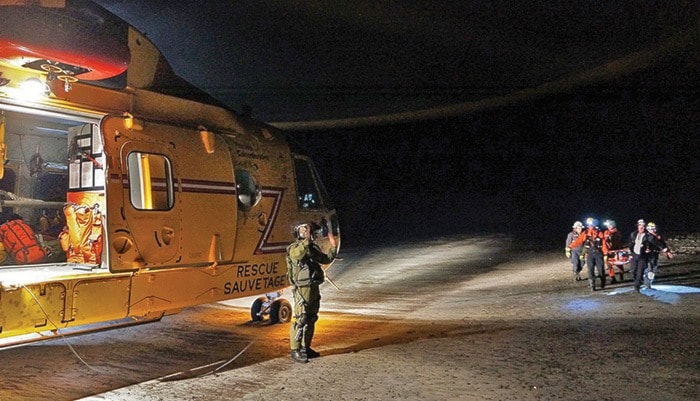It's 8 a.m. on Tuesday morning when CFB Esquimalt's warning system sirens go off.
The Big One — a 9.0-magnitude earthquake — has struck the West Coast, followed by a massive tsunami that has caused catastrophic damage to the cities of Victoria and Vancouver, along with a number of coastal towns along Vancouver Island.
Port Alberni has been hit particularly hard. Docks and bridges were damaged in the tsunami, dozens of people are left stranded or stuck under cars that have been crushed by fallen trees. A pack of tourists are emotional and stranded at Pacific Rim National Park, and in need of rescuing.
Staff at CFB Esquimalt spring to action.
First, they gather emergency kits and head outside to dedicated muster stations where they're briefed on the natural disaster that has just struck the region.
Cell towers and civilian landlines are down, forcing staff to test alternative communications such as satellite phones and radio systems. Once communications are up and running, staff return to work, coordinating with personnel in Emergency Management B.C. in Saanichton, headquarters in Ottawa and army support elements in Edmonton.
The regional operations centre then works to find out what's happening on the ground, confirming and putting all information (such as information about people stranded in a certain community) on a board or map so everyone is aware of the scenario.
Teams are then sent to inspect the structural integrity of docks and bridges after being hit by a tsunami. Rescue teams are deployed and military aircrafts deliver mobile medical clinics to Port Alberni.
While this natural disaster didn't actually occur on the West Coast, the Joint Task Force Pacific (which includes the Maritime Pacific Forces, the army and airforce) conducted training exercises in Esquimalt, Port Alberni, Bamfield, Vancouver and a number of other coastal areas, to simulate a natural disaster last week.
Exercise Staunch Maple is designed to test the joint task force's ability to provide humanitarian assistance and targeted key groups that could be deployed to support authorities in the event of a wide-spread emergency situation.
“If the exercise is done right, you feel like you're actually there living the real thing and the commander and the staff put a lot of pressure on themselves. You can see the strain on their faces just like you would during a real operation,” said Lt.-Col. Kevin Tyler, exercise director of Exercise Staunch Maple.
Most of the work done at CFB Esquimalt during the event of a natural disaster is communication either over the phone, face to face or by computer to help coordinate the military response in support of the province. Staff would help coordinate with the Forces, including ships, aircrafts and other elements such as urban search and rescue and diving teams that could be sent out to the affected areas.
In total, roughly 100 personnel from CFB Esquimalt participated in the exercise, along with roughly 500 to 600 others from across the country.
“The training audience here felt like they were in a real operation to a good degree,” Tyler said. “That (an earthquake and tsunami) is the most likely catastrophic scenario that would hit the region.”
Rear-Admiral Gilles Couturier, commander of Joint Task Force Pacific, said the exercise goes a long way to ensure the base is ready to provide assistance to the province during such emergencies.
